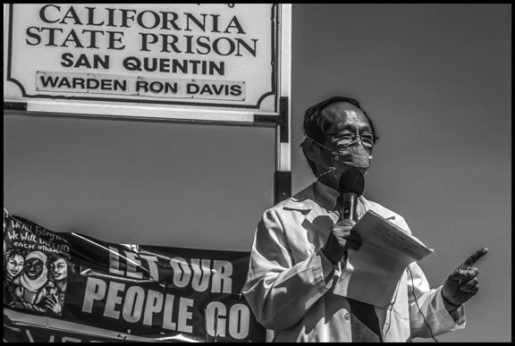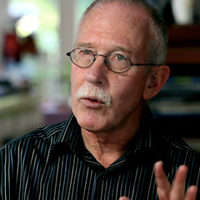
On Sunday, July 19, about a hundred people gathered at the gate of San Quentin State Prison in San Rafael, to call for the release of prisoners because of the terrifying spread of COVID-19 inside the facility. On May 30th the state Department of Corrections and Rehabilitation transferred 121 prisoners from the California Institution for Men prison in Chino into San Quentin. At the time there were no known cases of the virus in San Quentin, while Chino was a recognized hot spot.
The coronavirus infection spread rapidly through San Quentin. According to the California Department of Corrections and Rehabilitation [CDCR], as of the date of the vigil, there were 928 active cases and eleven prisoners had died.
Less than half of the prison’s current 3,524 population had been tested in the two weeks prior to the vigil. According to the CDCR, the concentration of confirmed cases at San Quentin is 621.9 per 1000. By comparison, for California (a hot spot state) as a whole, the confirmed case rate is 11.1 per 1000.

The vigil organizers include the Interfaith Movement for Human Integrity and the Stop San Quentin Outbreak Coalition, which describes itself as “a collective of formerly incarcerated folks, loved ones with direct connections to San Quentin State Prison, community organizers, and currently incarcerated folks at San Quentin State Prison.” Other participants came from the Ella Baker Center for Human Rights, Re:Store Justice and the Asian Prisoner Support Committee. The speeches and placards they carried demanded that Governor Newsom come to the prison, that the state grant large-scale releases without categorical exclusions (a 50% reduction in the prison population), and an immediate stop to all transfers between prisons and from prisons to ICE detention centers.
The day following the vigil a twelfth prisoner, Troy Ashmus, died of the coronavirus according to prison authorities. Five more prisoners have died in the past week, bringing the total number of deaths at San Quentin to 17. In just 25 days, the number of incarcerated people at San Quentin with COVID-19 went from zero to over a thousand active cases. As the numbers rise, demonstrations by desperate families have become increasingly frequent.
According to the CDCR, the state prison system now has 7,672 confirmed cases, of which 1,025 were reported in the last two weeks. Governor Newsom has announced that he will release 8,000 prisoners by the end of August, but over the next six weeks, the infected will likely number in the tens of thousands. With a prison population of 104,725 (123% of its designed capacity) there isn’t adequate space for isolation.
Laura Mondragon, wife of a prisoner, told the vigil participants that Newsom had to act more quickly to prevent more deaths. “Getting sent to San Quentin shouldn’t be an automatic death sentence,” she said. “But with the virus, there is a terrible risk that it will be for people like my husband.”
To see a full set of images of the protest, click here: https://www.flickr.com/photos/56646659@N05/albums/72157715250290036










